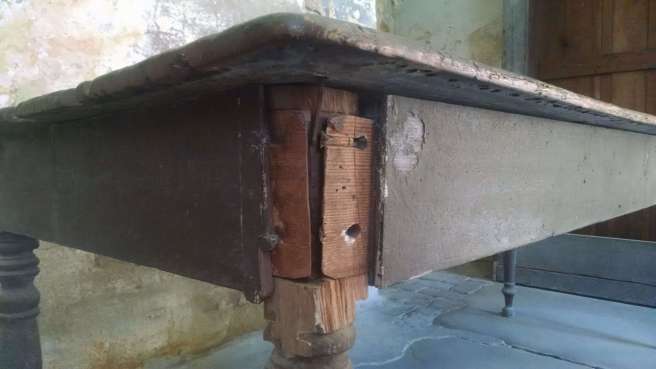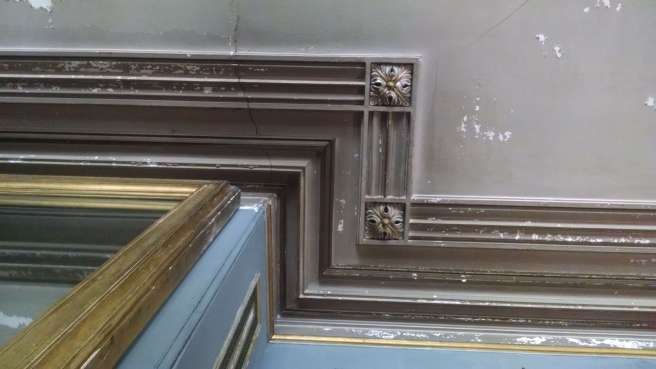(And a lot of alluring alliteration?)
I mentioned yesterday that I ran into something interesting at the antique store on Sunday. Of course, it may only be of interest to me, but I hope not, because I spent a couple of hours writing about it.
Rural southern antique stores tend to yield some peculiar offerings. (I’m sure it’s the same everywhere; I can only speak to my own experience). But every now and then you come across something worthwhile, which keeps the experience fun. If nothing else, it’s an opportunity to pull out drawers and peek inside of carcases in ways that museums and your neighbors might disapprove. The store that I visited on Sunday had a couple of mahogany tea tables that were worthy of a closer look.
(Actually, only one of them was worth a closer look, but I thought it might be helpful to compare an interesting one with a non-interesting one, side-by-side)

What is your first impression when you see the tables in the photo above? (Feel free to comment, because I’m curious what jumps out at other furniture-makers).
The tables are similar in their basic form: tripod tables, with legs joined to a central column, comparable in height, diameter, and footprint. But the differences are instantly apparent. The table on the left has a more pleasing finish: it looks smooth and matte, allowing the color and grain of the wood to take center stage. The table on the right has a glaring finish that obscures the wood and distracts the eye from the form. The table on the left has an attractively-shaped top, with a raised edge accented by six decorative C-scrolls. The table on the right has plain, round top with no raised edges.
That is where the credits to the table on the left come to an end. Looking below the top, we see that the right table has shapely, almost muscular legs. They look active and alive compared to the drooping, blocky legs on the table to the left.
More on the legs later. For now, let’s have a look at the columns (apologies, though, for the quality of these photos).
Though superficially similar, the turning on the right is far more competent and cohesive than the one on the left. On the column to the right, the variation in diameters is more dramatic and the separation of the various elements more assured. The column on the left features redundant repetitions of the elements above and below the urn; it lacks the punctuating bead on the upper portion of the taper; and the transition from the tapered section atop the urn to the wider part that supports the tabletop is slow and uncertain.
Now, back to the top for a closer inspection.

The plasticky film of polyurethane notwithstanding, the top of this table is a nice piece of wood. I didn’t measure it, but I would estimate it to be ~26″ wide from a single plank of solid mahogany. I will criticize the rim, however. Not every tea table can have a laboriously-carved pie crust top, but this table would definitely have benefited from a turned, raised edge.
The other table has a nicely carved edge, but all is not as it seems…

Notice in the picture below, the tell-tale clue of veneer separation:

And of course, if you examine the edge, you’ll see the sandwich of applied carvings, mahogany veneer, solid wood, followed by another layer of delaminating veneer. The shaping of the edge below the applied moldings is pretty half-hearted as well.

Alright now, let’s flip these things upside-down and take a look underneath:
If you haven’t figured it out by now, the story starts to unfold with these two photos. On the photo at left, look at how the leg is beginning to separate from the column. You can peek in (well, I could) and see the dowels that join the legs to the columns. Dowel joints were a mainstay of early-20th century Colonial Revival furniture – and that’s exactly what this table is.
Dowel joints are an inferior way to join two pieces of wood under almost any circumstances, but they are a particularly poor choice for a pedestal table, which, by design, keeps the lower portion of the joints under constant tension. A more typical apron table will only have tensioned joints when the legs are kicked or bent. The inadequacy of the joints is clearly demonstrated by the fact that it is already failing, probably less than 100 years into its existence.
The table on the right has legs joined by sliding dovetails bearing the distinct irregularities of hand-cut joints. Note the complete disregard for the appearance of the underside – saw marks and gouge marks are left untouched so that more precious time can be spent refining the appearance of the visible elements. These are all signatures of genuine 18th-century craftsmanship. This table is, I believe, a genuine 18th c. tea table that was unceremoniously slathered in high-gloss polyurethane by some poor misguided soul. The original finish may be destroyed, but the legs, properly joined to the column with sliding dovetails, is still tight and solid ~250 years after it was built.
Now, more on the legs.

I didn’t mention it above, but what really jumped out at me about the legs on the 20th c. table was the fact that they were completely inappropriate to be paired with the “pie crust” tabletop. This style of legs, with the beaded, concave upper surface, the unshaped sides, and the metallic foot, is Neoclassical, and would be at home in the early 19th c. on a “drum table“. The top is more typical of Chippendale furniture from the third quarter of the 18th c. So you have a mishmash of two styles separated by half a century that would never be found on an authentic period piece. It doesn’t matter how well-done the work is; if you combine a Neoclassical legs with a Chippendale top and a column that would not have been stylish in either period, you end up with an awkward and ungainly chimera.
On the other hand, the legs on the 18th c. table fit right in with the rest of the piece. They are curvaceous but not ostentatious, and very proficiently shaped.

The transition from the legs to the column is far more competent than the other table as well (of course it helps that the style of the legs is appropriate to that of the column). Above the knees, the legs sweep upward, drawing your eye to the turned elements of the column.

Finally, one more enhancement that the 18th c. table has over the 20th c. chimera: This one has the tilt-top that is typical of this period – a space-saving design that allows the table to be pushed up against a wall (or in a corner, depending on how the legs are oriented) when not in use. It’s more labor-intensive than a stationary top, but not so much as the more elaborate tilting- and rotating-tops that were also desirable during the period. A wooden pin fits into the battens, while a brass catch keeps the table from tilting during use.

Now, where was the table built? I honestly have no idea, but my best guess is that it was imported from England. Still, it’s an attractive but relatively simple table that I would be pleased to own (after a thorough re-finishing job) or reproduce.
So what was the price?

$275. I’m not an expert, but I don’t consider that a bad price for a genuine 18th-century piece (I could be wrong here, could be worth 5o bucks at auction, for all I know). But given the work that would be required to make it presentable again, I had to pass. I think the other table was in the neighborhood of $125, but I wouldn’t care to own it at any price.







































































